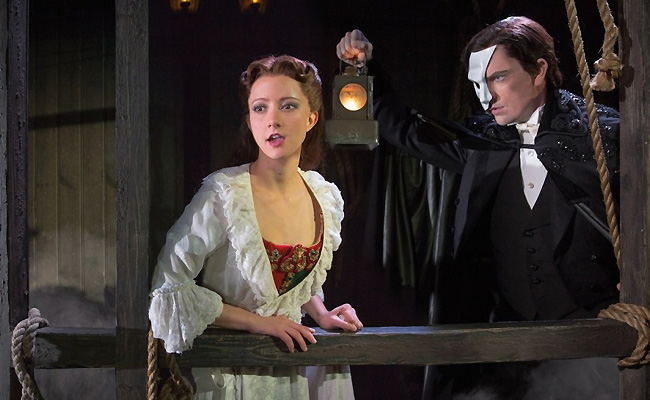
Matthew Murphy
Gaston Leroux’s Phantom of the Opera has been haunting imaginations since the book was first published in 1910. Lon Chaney brought the misunderstood monster to life in a classic silent film in 1925, and he’s visited audiences on TV and in the movies in various incarnations ever since.
In 1986, Andrew Lloyd Webber gave the Phantom new life and new fans when his lavish musical opened in London’s West End, followed by a Broadway edition that is still playing 28 years later. The show has toured the country for almost as long, but a new production launched in 2013 has applied new technological wizardy to the show, as well as new costumes and production design that will simply wow audiences. Don’t worry though, Webber’s and Charles Hart’s classic score remains intact.
You probably know the story by now, so we’ll just give you a brief recap: The Paris Opera House has a diva problem in Carlotta Giudicelli (Jacquelynne Fontaine) who storms out of the theatre after new owners fail to acknowledge the strange goings-on for the past three years. Who will fill her shoes? Ballerina Christina Daaé (Katie Travis), who has been taking voice lessons from a very mysterious tutor. An old flame, Raoul (Storm Lineberger), comes back into her life, setting the stage for a romantic triangle that will bring disaster to the theatre and, possibly, their lives.
Full disclosure: I saw The Phantom of the Opera back in the early 90s and was not really impressed. I didn’t really see what all the fuss was about, and the score had several hummable tunes, but there was a lot of moments when a dozen characters would all be singing at the same time that made it impossible to know what any of them were saying. On that count, not much has changed but I have to tip my hat to the actors for being able to stay focused on their own parts of the number. And the show’s major setpiece, the chandelier, more eased itself down to the stage rather than falling.
That was then. This newly staged production (not replacing the “brilliant original” that is still on Broadway) takes what’s already familiar — the music, the story, the characters — and adds a wow factor of, on a scale of one to ten, about one hundred. While much is made of the chandelier (and the new state of the art version weighs in at a hefty ton with lights, smoke and pyrotechnics built in), it really plays a small part in the first act of the show (and if you’re stuck in an area where you can’t really see it, it plays even less of a role), but for some members of the audience, it could be quite a heart-stopping moment.
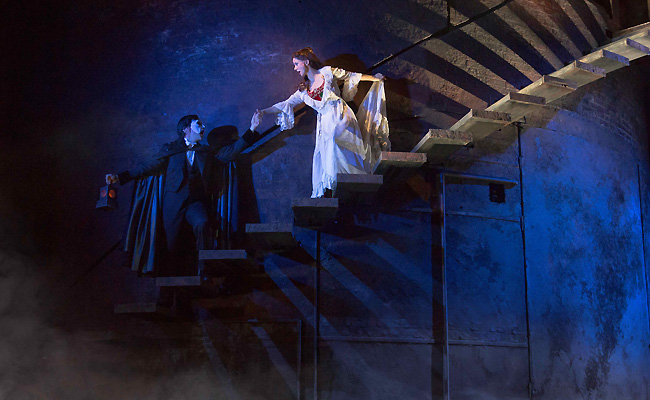
Matthew Murphy
The real wow factor is right on stage. If you want your big Broadway musical to have sets and costumes, then you’ve come to the right place. The new Phantom set is simply spectacular with two rotating columns on either side of the stage that represent part of the proscenium, the box seats of the opera house, or the catacombs below. The centerpiece, however, is a ten-ton wall, a half circle that rotates, opens up, and splits in half to become various other parts of the set. One of the most amazing moments comes during “The Phantom of the Opera” number with the Phantom and Christine at the top of the wall, probably 40 feet off the stage, and then descending down steps that magically slide out of the wall and back in before Christine can change her mind about following her “Angel of Music.” I didn’t know if my head was going to explode or if I’d just start sobbing because I was so astonished by the masterful wizardry that has gone into this show. The set really is as much as star as any of the cast members. I thought Book of Mormon had amazing sets, but this one takes the cake.
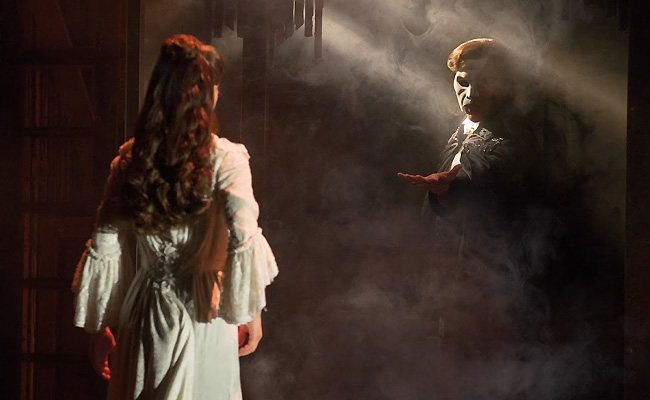
Matthew Murphy
Before I talk about the cast, I also have to commend the tech crew on this show. I have never seen a more perfectly presented show than I have with Phantom. The lighting is amazing to begin with, but when someone has to follow an actor with a spot, there’s almost always a problem of not keeping up with the actor or just being to high or too low. Not here. Every spot was perfect, and I loved how in one number Christine would walk from one side of the stage to the other, with one spotlight from above the set coming on and another going off and vice versa as she walked back to the other side. The sound was perfect as well. The orchestra never over-powered the singing, and the audio effects with the Phantom as his voice traveled around the inside of the theatre was also a nifty effect. This was the most technically perfect show I have ever seen. (Be sure to check out our behind the scenes chat with Stage Manager Jovon Shuck to find out what it takes to get this show going.)
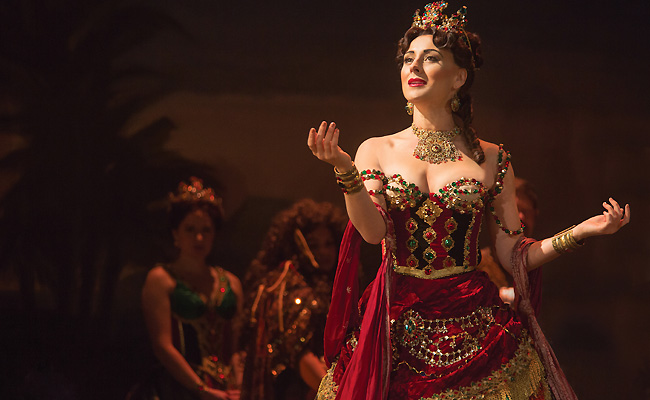
Matthew Murphy
With that out of the way, we can’t overlook the contributions. The first of the main characters we meet is the diva Carlotta, an impossible woman to deal with, but the toast of Paris, so what’s an opera house owner to do? Jacquelynne Fontaine (who is a delight in person) brings a haughtiness to the character, but not enough that you want the Phantom to do her harm. Fontaine also has a lovely voice that soars into an operatic range, and plays the comedic moments nicely.
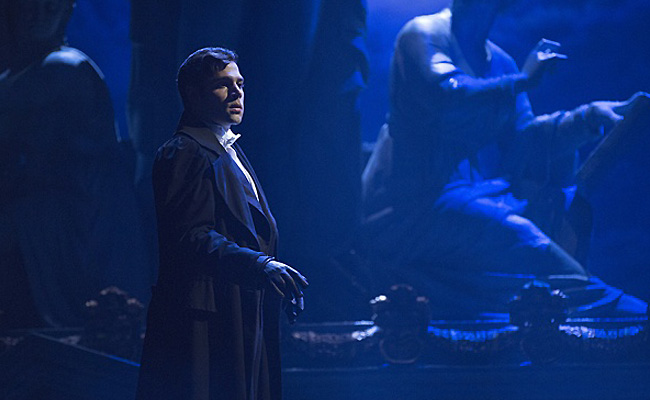
Matthew Murphy
Storm Lineberger is a dashing Raoul, a man who has loved Christine since they were children. Raoul probably has the least character development as he just shows up and is in love with Christine and then trying to convince her the Angel of Music is just in her head, and then puts himself in charge of capturing (or killing) The Phantom when he sees that he is just a man. Lineberger overcomes any shortcomings of the character with a powerful stage presence and a beautiful voice.
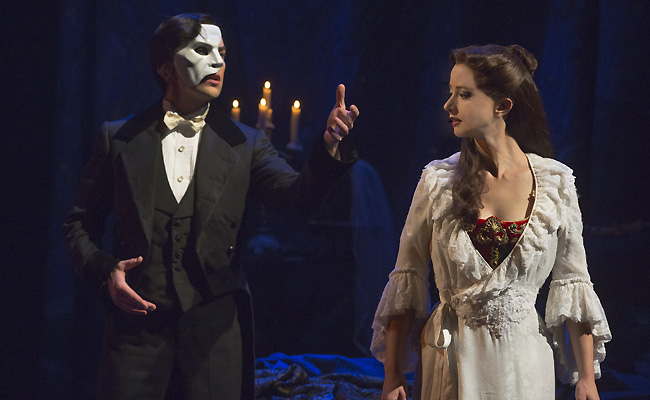
Matthew Murphy
Also with a beautiful and powerful is Katie Travis, who demonstrates a wide range and can almost shatter glass when she has to hit those high notes at the end of the “Phantom of the Opera” number when he keeps telling her to sing. Higher and higher she goes, and you wonder how she does it. She also brings a naivety to Christine as she goes from chorus girl/ballerina to star, all the while believing she has a ghost or guardian angel watching over her (and the Phantom makes it quite clear she must obey him … which is kind of creepy). But she grows over the course of the show, even using her wiles to convince the Phantom she is his. Travis really is the glue that hold the show together.
The Phantom, Chris Mann (who was a finalist on The Voice, has almost the same problem as his character as Lineberger does with Raoul. The Phantom is a bit of an obsessed control freak once Christine actually meets him, and while he has helped her hone her talents, his obsession borders on dangerous. It’s a bit one-note. How could anyone be expected to fall in love with that personality? You want to feel something for the Phantom, especially at the end, but it’s Christine who makes you feel for him. That, however, is not Mann’s fault. He actually seems to be trying to make the Phantom more sympathetic when he first brings Christine to his subterranean lair, but he’s required to switch emotions on a dime that it’s hard to keep up. Mann does have a magnificent voice and he does give the Phantom that needed menace, especially in the second act as he becomes more unhinged. And kudos to Mann for being able to bring those different shades to the character while wearing prosthetic makeup and half a mask. It’s a hard character to root for, but Mann manages to make you feel for him in the end.
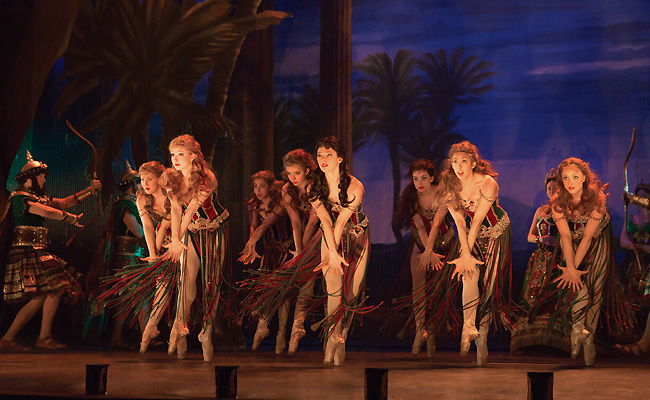
Matthew Murphy
I also want to give a shout out to the rest of the cast for always being engaged while on stage, even if their character isn’t really doing anything. I’ve seen shows where sometimes it feels like the supporting players are only giving half the effort to perform, but whenever people are on stage, even far in the background, they’re always doing something instead of just watching and reacting to the main action. Credit also goes to director Laurence Connor for having the wherewithal to give the supporting cast things to do. It really helps the audience get into the show as well.
In 1991, I wasn’t a fan of The Phantom of the Opera even though I had the highest of expectations. I found it rather forgettable. The new production has definitely converted me. From the cast and orchestra to costumes, lighting and the truly remarkable scenic and production design, this is one production that I will never forget.
The North American tour of The Phantom of the Opera runs through February 7 at Baltimore’s Hippodrome Theatre. Other cities on the schedule include Jacksonville, Miami, Nashville, Syracuse, Omaha, Indianapolis, Cleveland, Washington DC and more. Visit the official Phantom website for more information.


Excellent, Chuck. Wish I could see it since it sounds like a wonderful production!
Hopefully they’ll bring the show to your area at some point.